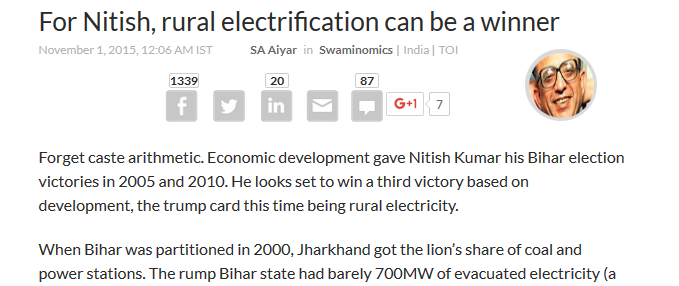Forget caste arithmetic. Economic development gave Nitish Kumar his Bihar election victories in 2005 and 2010. He looks set to win a third victory based on development, the trump card this time being rural electricity.
When Bihar was partitioned in 2000, Jharkhand got the lion’s share of coal and power stations. The rump Bihar state had barely 700MW of evacuated electricity (a measure of actual consumption), less than one-fifth that of Delhi. Creating new power stations and coal linkages constituted huge hurdles for a bankrupt government. Not a single new power station came up in Nitish’s first term, though some did so in his second term. In August 2012, evacuated electricity was up to 1,900 MW, more than double the 2005 position but still pathetically inadequate for a population of 110 million. Of the state’s 40,000 villages, 36,000 were classified as “electrified”, but actually got little or no power. The distribution system was kaput, with burned-out transformers and collapsed electric poles.
Nitish made rural electrification a key development thrust for this election. Pratyaya Amrit, a civil servant who spearheaded the thrust on roads in Nitish’s first term, was brought in to do for electricity what he had done for roads. Latest data suggests he may have done enough to win Nitish re-election.
Earlier, when power was scarce, every state generated its own electricity. But the eastern grid has recently started generating a big surplus, so Bihar can buy power from the grid provided its own transmission system can utilize it. Improved transmission has been Amrit’s priority. Upgrading transmission at breakneck speed now enables Bihar to evacuate almost 3,400MW. This is more than four times the 2005 level, and almost 70% higher than in August 2012, when the new thrust began. It has come bang on time for the 2015 election.
I am currently touring Bihar, and villagers say that electricity is available for 12-18 hours a day. City-dwellers say they get electricity almost all day, but with intermittent outages. Voters everywhere declare this is a major blessing, and give Nitish the credit for it. This looks a potential election winner.
Pratyaya Amrit says that of the 36,000 supposedly electrified villages, intensified electrification was needed to boost actual consumption in 11,000 villages. More than half the 4,000 non-electrified villages of 2012 have now been electrified, and 100% electrification is scheduled for April 2016. No less than 20 lakh new consumers have been registered, of whom almost 9,000 are in the newly electrified villages. Many illegal connections have been regularized. Amrit claims that much of the theft of electricity in earlier days was induced by callous non-supply. Those stealing earlier are today happily paying for regular supply.
How does Bihar’s recent rural electrification thrust compare with that in other states? On March 31, 2015, India still had 18,452 non-electrified villages of which 2,719 were in Bihar, the other main culprit being Odisha. Six months later, on October 12, 2015, Odisha had electrified just one additional village, whereas Bihar had electrified an additional 1,427. Quite a difference.
The transmission focus has been on quality, not just increased quantity. The first task was to survey all supposedly electrified villages and repair poles and transformers. Contractors earlier dragged their feet because they claimed to face enormous problems (and bribes) in getting their bills paid. A streamlined payments system, and meetings where contractors and government engineers sort out differences on the spot, have helped speed up electrification and raise the productivity and motivation of contractors and sub-contractors. A consumer redress system has been set up with 24/7 helplines, and widespread advertising has sought to make villagers aware of the helplines. In the past, consumer grievances were routinely ignored, but things have improved in the last 18 months because of the shadow cast by the imminent state election.
Many problems remain. The technical and commercial losses of Bihar’s electricity system are huge and unsustainable. They have been reduced from a hair-raising 54% to a still outrageous 40%. This needs to come down to 10% to be world class. Checking theft is relatively easy if the consumers are a few large industries, but difficult if (as in Bihar) 95% of consumers are households and offices. Building more substations with better transformers can cut technical losses, but there is a long hard slog ahead.
Only 42% of consumed electricity used to be billed. This is now up to 67%, which is still pathetic. Only 80% of billed sums are actually being collected, though this again is an improvement on the earlier 69%. Bihar has a long way to go. But it seems to have progressed fast enough at just the right time to give Nitish a third victory.


